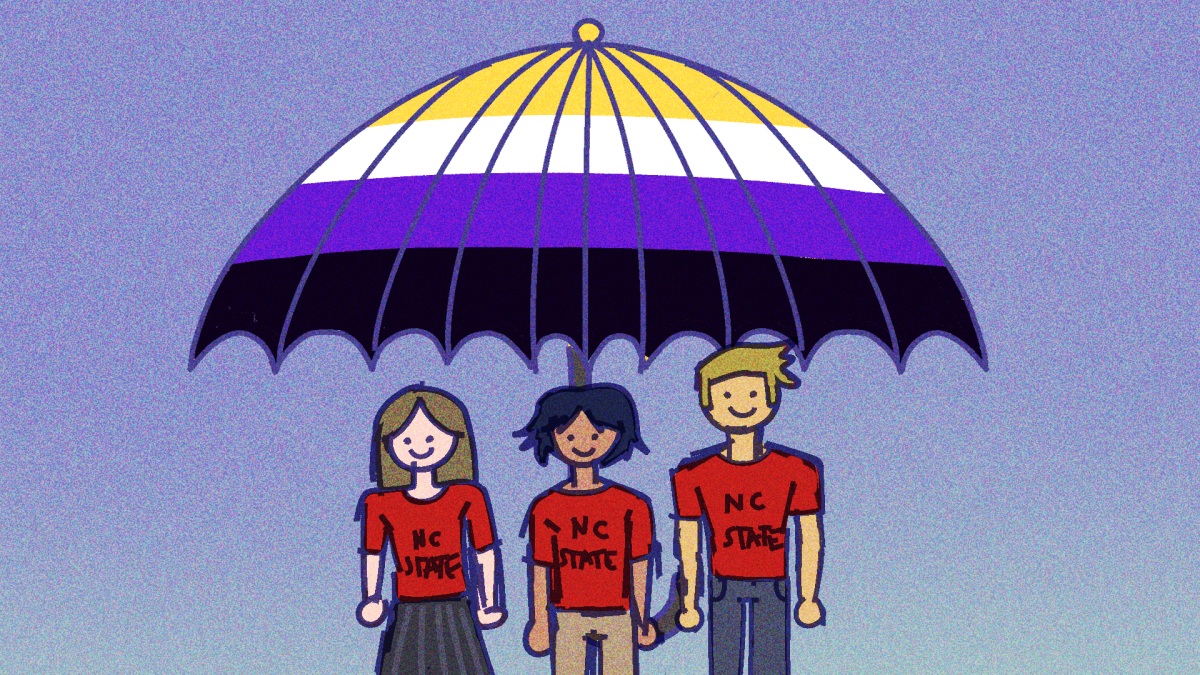
Angel Chen, Graphic Illustrator
Gender has become a highly polarized subject within the past two decades, impacting education, media and politics. As a result, people may find themselves questioning their own gender identity and discovering that they align outside of societal norms.
While the spectrum of gender continues to expand, it becomes increasingly clear that the gender conventions our society has outlined as standard are based solely upon social constructs. As these conversations continue, labels emerge, with “nonbinary” becoming one of the more common ones. Someone is nonbinary when their gender experience doesn’t conform with societal standards of female or male genders.
For nonbinary people, it can feel almost required to present androgynous. Societal norms tell us that if we do not fit into a binary gender then we must not present as such. But the pressure to fit into what a gender non-conforming person “should” look like goes against the entire basis of the nonbinary identity.
People both in and outside of the LGBTQ+ community hold stereotypes about nonbinary people, whether they are aware of them or not. One common misconception is that nonbinary people always present as androgynous.
These ideas are rooted deeply in the lack of media representation of nonbinary and gender- nonconforming people. In the few instances where characters — at least on-screen — are openly out as nonbinary, they are also all presented as androgynous, as seen in shows such as “Abbott Elementary” and “Sex Education.”
This representation is not a negative thing, and some nonbinary people do present androgynous. But, at the same time, there are many people who present as feminine or masculine who still identify as nonbinary. A lack of realistic portrayal of gender-nonconforming people in media greatly influences the general population’s views on how a nonbinary person is expected to appear.
Tal Brafford, a nonbinary graduate student studying clinical mental health counseling, said that gender-nonconforming people don’t owe it to anyone to look a certain way.
“I think kind of the point of having or aligning with a nonbinary identity, specifically is that you’re subscribing to a policy that is more expansive than that. So saying that I necessarily have to present a certain way, or even owe somebody some ambiguity or some androgyny, I think is antithetical to the identity,” said Brafford.
I myself am nonbinary, something that I have known almost my entire life but couldn’t quite put a finger on until I was a teenager. I reached this understanding thanks to growing representation and dialogue around gender identity. For quite a while though, I struggled with my gender expression and figuring out how to present in a way that was both aligning with my identity as well as conveying my personal style.
“I think there, there’s a lot of internalized transphobia, and specific to non binary identities — I find it typically in younger people, young adults — that they maybe have this misconception that they also have to perform a gender or perform ambiguity for society,” Brafford said. “It’s hard feeling “trans enough” if you’re not inside of that [expected] identity.”
I carried this misconception for several years after coming to terms with my own gender identity. In regards to pronoun use, it felt easier to dress androgynous than anything else just to convey to those around me that I was not cisgender. I find that now, as I dress more feminine, I am rarely ever asked for my pronouns and am typically assumed to be a woman.
This brings back the central issue; that we as a society need to stop seeing nonbinary people only in an androgynous way. Gender is a spectrum, so why not embrace the wholeness of it rather than only bits and pieces?
“I think it [gender expression] should be playful,” Brafford said. “I think there should be more freedom and less expectation about how you show up, right? And that changes day to day, if I’m feeling softer today, and maybe that makes me inclined to express more femininity, and then tomorrow I feel differently, I shouldn’t have to justify that feeling.”
Brafford said that, both inside and outside of the LBGTQ+ community, educating those who may not be as familiar with the trans and nonbinary experience is paramount to eliminating the stigma of androgyny.
As a society, we can improve the experiences of nonbinary people by being mindful of the range of ways gender non-conformity can be expressed, whether androgynous or not. Ask what pronouns people use. Don’t assume anyone is a certain gender just by looking at them.
And for LGBTQ+ individuals, continue to be an ally for your peers, continue to stick up for yourselves and for those in the community. If you ever feel isolated or alone make sure to check out the LGBTQ Pride Center in Talley. Don’t become complacent with what is just because you aren’t sure if things can change. They have, and they will.